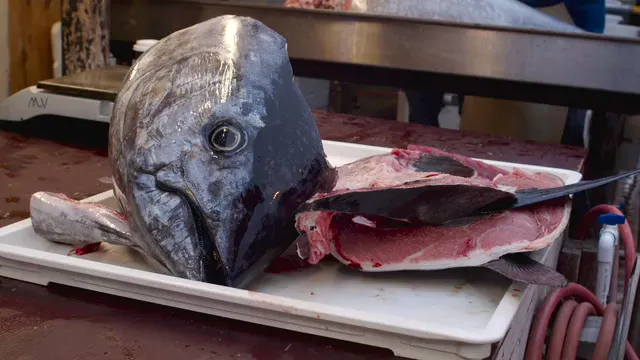
Why Do Fish Markets Operate at Night?
Introduction
Night fish markets are vibrant hubs of activity. They hold cultural significance in many communities. These markets operate during unique hours, creating a bustling atmosphere after sunset. The demand for fresh seafood drives their late-night operations.
In these markets, you can find a wide variety of fish and seafood. Whether it’s tuna, salmon, or shellfish, everything is fresh and ready for sale. Night markets cater not only to local chefs but also to home cooks seeking quality ingredients. If you’re one of those home cooks, you’ll want to check out this Fresh Seafood Cookbook to create culinary masterpieces at home!

Summary and Overview
Fish markets that operate at night provide a different experience than traditional daytime markets. During the day, many fish markets are quieter and less dynamic. However, nighttime brings energy and excitement, with vendors calling out to attract customers.
Historically, these night operations have roots in fishing practices. Fishermen often catch fish during the night, ensuring freshness for the market. This practice aligns with the logistics of transporting seafood from boats to stalls, emphasizing seafood freshness.
Economically, night fish markets play a crucial role in local communities. They support local fishermen and vendors, generating jobs and income. In addition, these markets often reflect the unique culinary traditions of their regions. To help you maximize your seafood experience, consider investing in a Fish Filleting Knife for perfect fillets every time!
Globally, renowned night fish markets exist in various locations. For example, Tokyo’s Toyosu Market is famous for its early morning tuna auctions. Billingsgate Market in London and Hamburg’s Fish Market also capture the essence of night-time seafood trading. Each of these markets showcases local culture and traditions while providing fresh seafood to enthusiastic customers.

The Night Fish Market Phenomenon
Why Fish Markets Operate at Night
Ever wondered why fish markets spring to life when the sun goes down? The answer lies in a mix of tradition, logistics, and demand for seafood freshness. Many fishermen prefer to catch fish during the night. This ensures that fish arrive at markets just hours after being caught, keeping them as fresh as possible.
Freshness is critical in the seafood industry. Fish caught in the early hours can be delivered to markets before dawn. This timing allows vendors to showcase the best quality products when buyers are most active. It’s all about meeting market demand, especially for restaurants and chefs who prioritize top-notch ingredients. And if you’re grilling those fresh catches, an Electric Fish Grill Basket can make the job a whole lot easier!
The fish supply chain plays a vital role here. Boats return to the docks early in the morning, where fish are quickly transported to markets. This process involves various logistics, including refrigeration and careful handling to maintain quality. For vendors, the night market provides a strategic opportunity to attract customers looking for the freshest seafood.
Night fish markets not only cater to local demands but also reflect the fishing industry’s rhythms. The bustling atmosphere, combined with the promise of quality, creates a unique shopping experience. From local chefs to home cooks, everyone finds something special in these vibrant night markets. It’s a win-win for all involved, ensuring that the freshest catches make it to your plate. And hey, if you’re planning a seafood feast, don’t forget to grab a Seafood Platter to display your delicious creations!

Economic Aspects
Economic Impact of Night Fish Markets
Night fish markets provide significant economic benefits to local fishermen and vendors. These markets create a direct link between fishermen and consumers. By operating during the night, they ensure that fresh seafood reaches customers without delay. This freshness is vital, as it boosts the market’s appeal and drives sales.
Job creation is another vital aspect of night fish markets. These markets employ various individuals, from fishermen to vendors, and even support logistics workers. Many of these jobs are essential for local economies. For example, in Tokyo, the Toyosu Market employs thousands, contributing to the livelihoods of many families. And to ensure you’re cooking those fresh fish perfectly, an Instant Read Meat Thermometer is a must-have for perfecting your cooking!
Sales volume in night markets is impressive. In cities like Tokyo and Hamburg, the revenue generated can reach millions each year. For instance, the Toyosu Market alone handles around 1,400 tons of seafood daily. This volume underscores the market’s importance in the economic landscape.
Moreover, night fish markets often stimulate surrounding businesses. Restaurants, bars, and local shops benefit from the influx of customers drawn to these lively markets. This interconnectedness enhances the local economy, making night fish markets essential hubs of commerce.
In summary, the economic impact of night fish markets extends far beyond fresh seafood sales. They create jobs, support local economies, and boost surrounding businesses. The synergy between fishermen, vendors, and local communities fosters a thriving economic environment.

Case Studies of Notable Night Fish Markets
Examples from Around the World
Night fish markets around the globe showcase unique cultural and economic dynamics. Here are some noteworthy examples:
Tokyo’s Toyosu Market
Tokyo’s Toyosu Market is a world-famous hub for seafood trading. The auction process begins at midnight. Vendors and buyers gather to bid on the freshest catches. Tuna auctions are particularly thrilling, drawing attention from chefs and seafood enthusiasts alike. The market offers a remarkable variety, including bluefin and southern bluefin tuna. Operated with strict hygiene standards, it ensures the quality of seafood remains top-notch.
Hamburg Fish Market
The Hamburg Fish Market operates every Sunday morning. This vibrant market attracts both night owls and early risers. Established in 1703, it has a rich history. The lively atmosphere is punctuated by enthusiastic vendors, creating a carnival-like ambiance. Visitors can enjoy fresh fish, fruits, and even live music. Many enjoy fish sandwiches while mingling with locals and tourists. The market serves as a social hub, fostering community connections. If you’re planning a picnic with friends, don’t forget to bring a Picnic Basket Set to carry all those tasty treats!

Billingsgate Market in London
Billingsgate Market is the UK’s largest inland fish market. Established in the 16th century, it has a storied past. Traders typically start their day around midnight, preparing for the market’s opening at 4 AM. This market provides high-quality fish to London’s finest restaurants. With its historical significance, Billingsgate reflects the evolving tastes of the city. The upcoming relocation aims to enhance logistics and improve the overall experience for vendors and customers.
These markets not only serve as commercial entities but also embody cultural traditions and community engagement. They highlight the importance of fresh seafood while contributing to local economies. Each market tells a story, reflecting the unique relationship between communities and their seafood.

Logistics and Operations
Supply Chain Management in Night Fish Markets
Night fish markets thrive on a well-organized supply chain. Fresh fish are transported from fishing docks to markets in the early hours. Fishermen catch fish overnight, ensuring optimal freshness for consumers. Once the boats dock, the fish are sorted and quickly transferred to refrigerated trucks. These trucks maintain the cold chain, preserving the quality of the catch.
Quality control is crucial in these markets. Vendors inspect fish upon arrival, checking for freshness and proper handling. Ice is often used to keep products chilled during transport and display. This attention to detail ensures that customers receive only the best seafood. To make the cooking process easier, a Seafood Steamer can make everything a breeze!
Technology plays a significant role in modern fish market operations. Digital tracking systems monitor the entire supply chain, from catch to sale. These systems help vendors manage inventory efficiently, reducing waste. Additionally, advanced refrigeration techniques maintain optimal temperatures, safeguarding the fish’s quality. With these innovations, night fish markets can keep up with consumer demand while ensuring safety and freshness.
The synergy between fishermen, transporters, and vendors forms a robust network. This collaboration ensures that seafood lovers enjoy the freshest products possible, making night fish markets a preferred choice for quality seafood.

Challenges Faced by Night Fish Markets
Operating at night presents unique challenges for fish markets. One major issue is competition. Vendors must continually attract customers in a bustling environment. To stand out, many markets emphasize unique offerings and superior freshness. They often create a vibrant atmosphere to draw in shoppers.
Hygiene is another concern. Night markets must adhere to strict health regulations to ensure food safety. Many employ dedicated staff for cleaning and maintenance throughout the night. Regular inspections help ensure compliance with industry standards. This commitment to cleanliness fosters consumer trust and encourages repeat business.
Sustainability is increasingly important, too. Many markets are adopting practices that promote eco-friendly fishing. They collaborate with local fishermen to ensure responsible sourcing. This approach helps maintain fish populations and supports local economies.
Moreover, regulations regarding food safety and quality are paramount. Markets must comply with local health codes, which can be complex. Adhering to these regulations not only promotes safety but also enhances the market’s reputation. As night fish markets evolve, overcoming these challenges will be vital for their continued success.

Conclusion
In summary, night fish markets play a vital role in our economy and culture. They ensure fresh seafood reaches consumers at optimal times. Fishermen often catch fish at night, aligning perfectly with market hours. This practice guarantees freshness and quality, vital for culinary experiences.
These markets are not just places to buy fish; they serve as social hubs. Friends and families gather to enjoy the vibrant atmosphere and engage in lively conversations. The significance of night fish markets transcends mere commerce; they embody community spirit and tradition. And if you want to capture those memories, a Recipe Journal might be just what you need!

I encourage you to visit your local night fish market. Experience the energy of the vendors and the diverse seafood offerings. You might just find your new favorite dish or recipe inspiration. And if you’re thinking about how to store your fresh finds, consider a set of Food Storage Containers to keep everything fresh!
FAQs
Why do fish markets open so early?
Fish markets often open early to ensure customers get the freshest seafood. Fishermen catch fish during the night, allowing them to deliver fresh catches by morning. This timing is essential, especially for restaurants that prioritize quality ingredients.
Are night fish markets safe to visit?
Yes, night fish markets maintain strict safety and hygiene practices. Vendors are committed to ensuring cleanliness. Regular inspections help uphold these standards, making night markets a safe choice for consumers.
What types of seafood can I find at night fish markets?
You can find various seafood, including tuna, salmon, shrimp, and shellfish. Many markets also offer seasonal specialties depending on local catches. The variety is often impressive and reflects regional preferences.
How do fish markets ensure the freshness of their products?
Fish markets rely on efficient logistics to maintain freshness. Fish are caught, transported, and displayed quickly. Vendors use ice and refrigeration to keep seafood at optimal temperatures, ensuring quality for customers.
Are there any cultural traditions associated with night fish markets?
Absolutely! Many cultures have unique traditions linked to night markets. In some areas, these markets host community events, live music, or food festivals. They provide a space for locals to gather, celebrate, and share culinary experiences.
Please let us know what you think about our content by leaving a comment down below!
Thank you for reading till here 🙂
All images from Pexels




